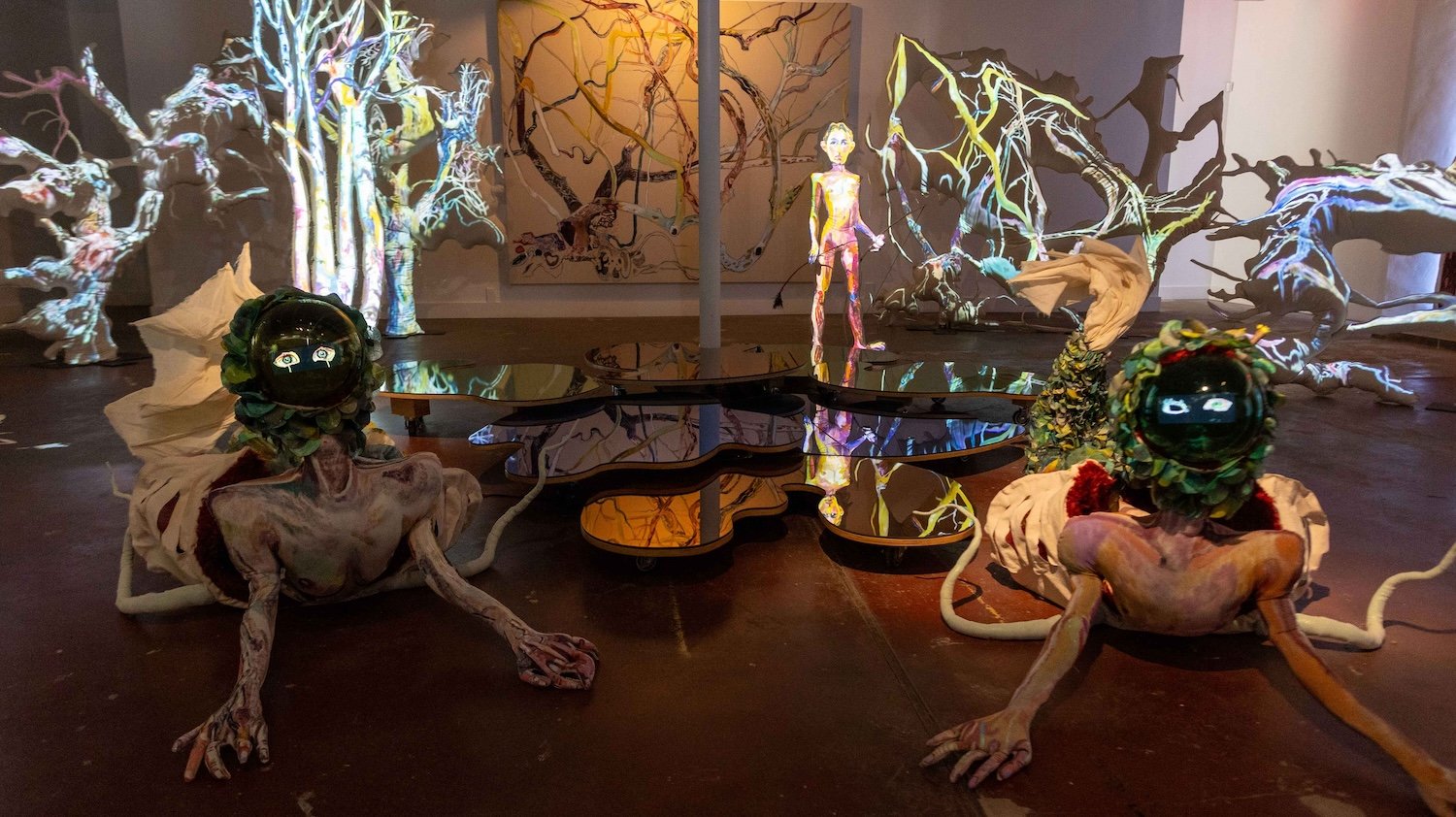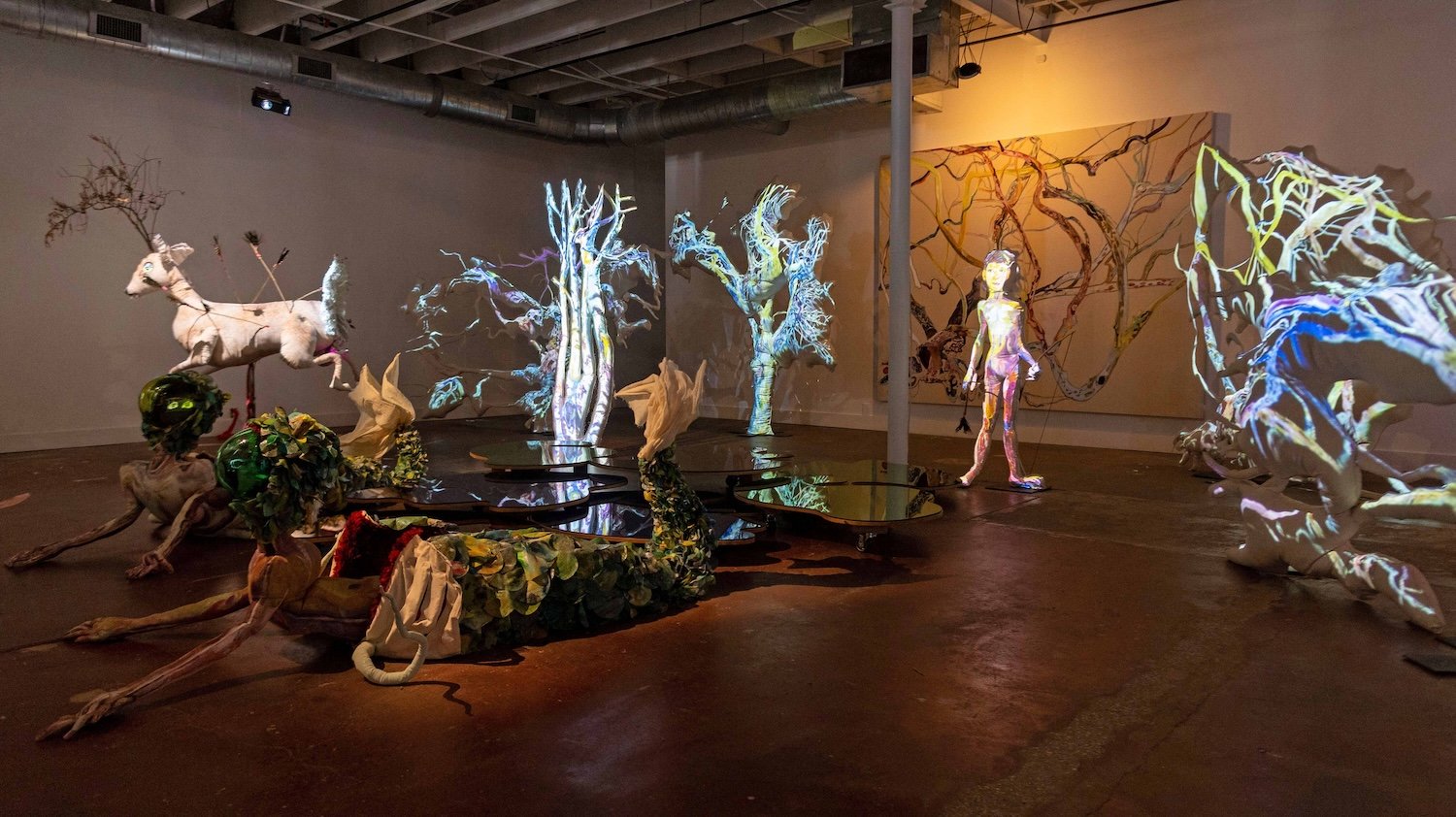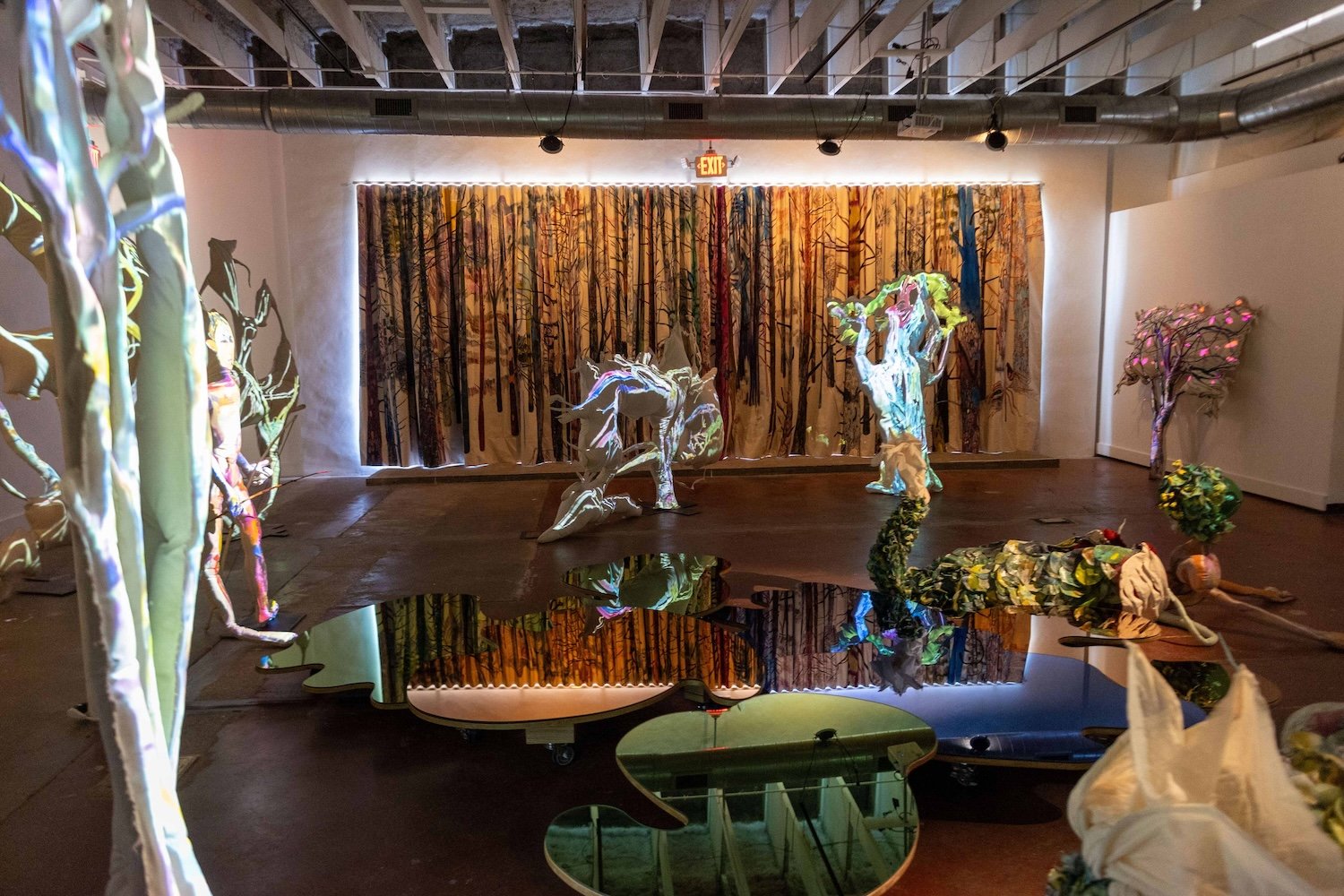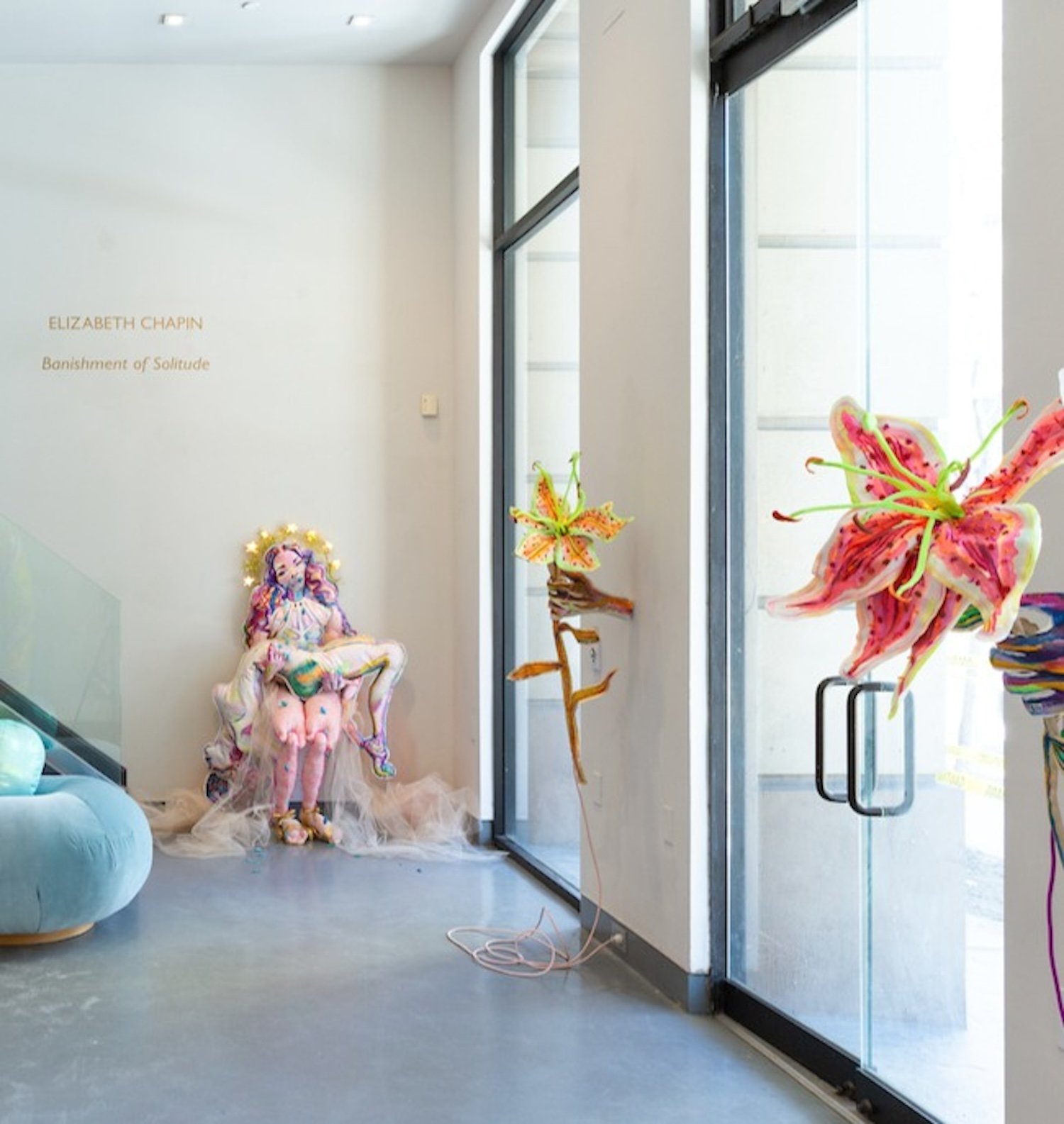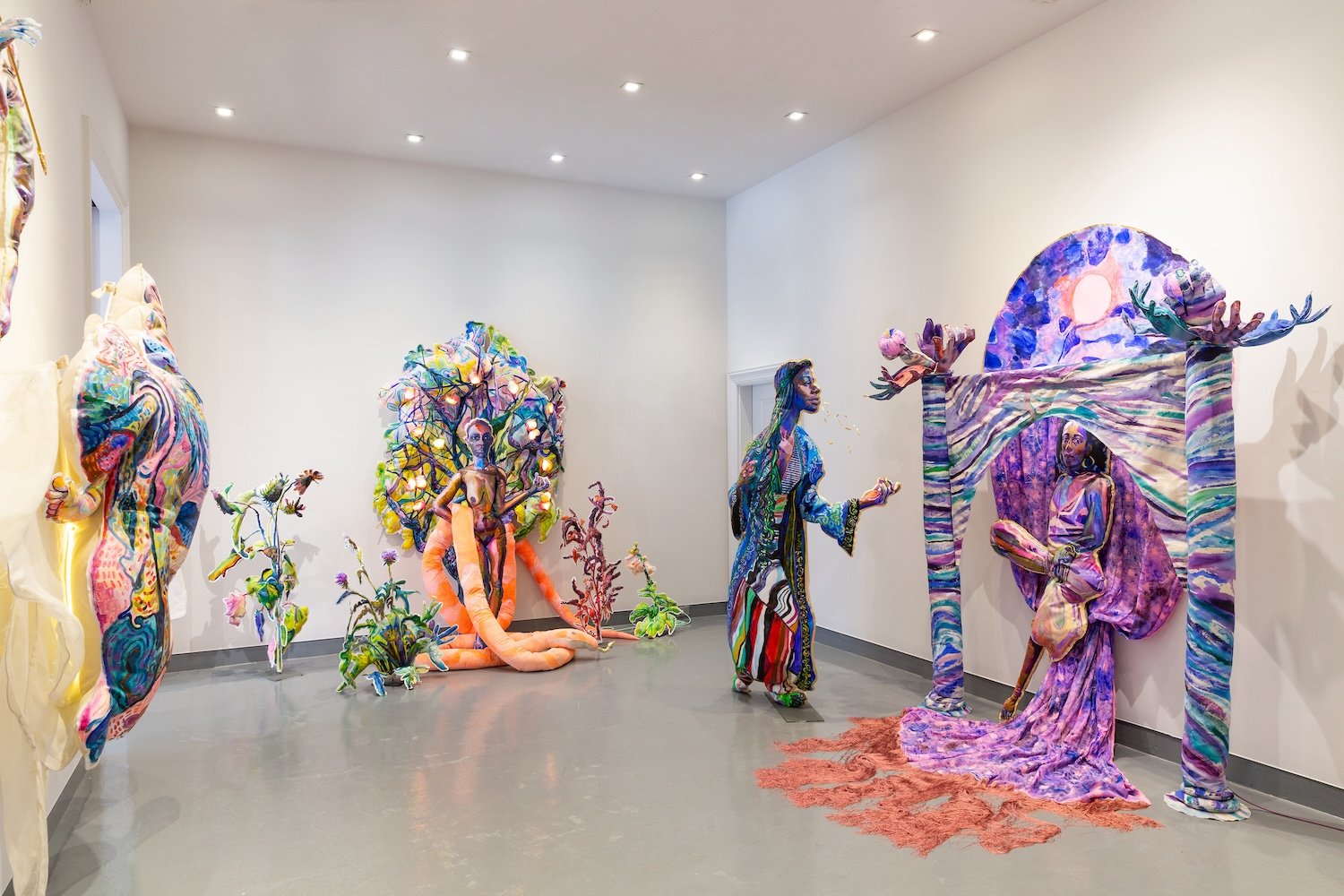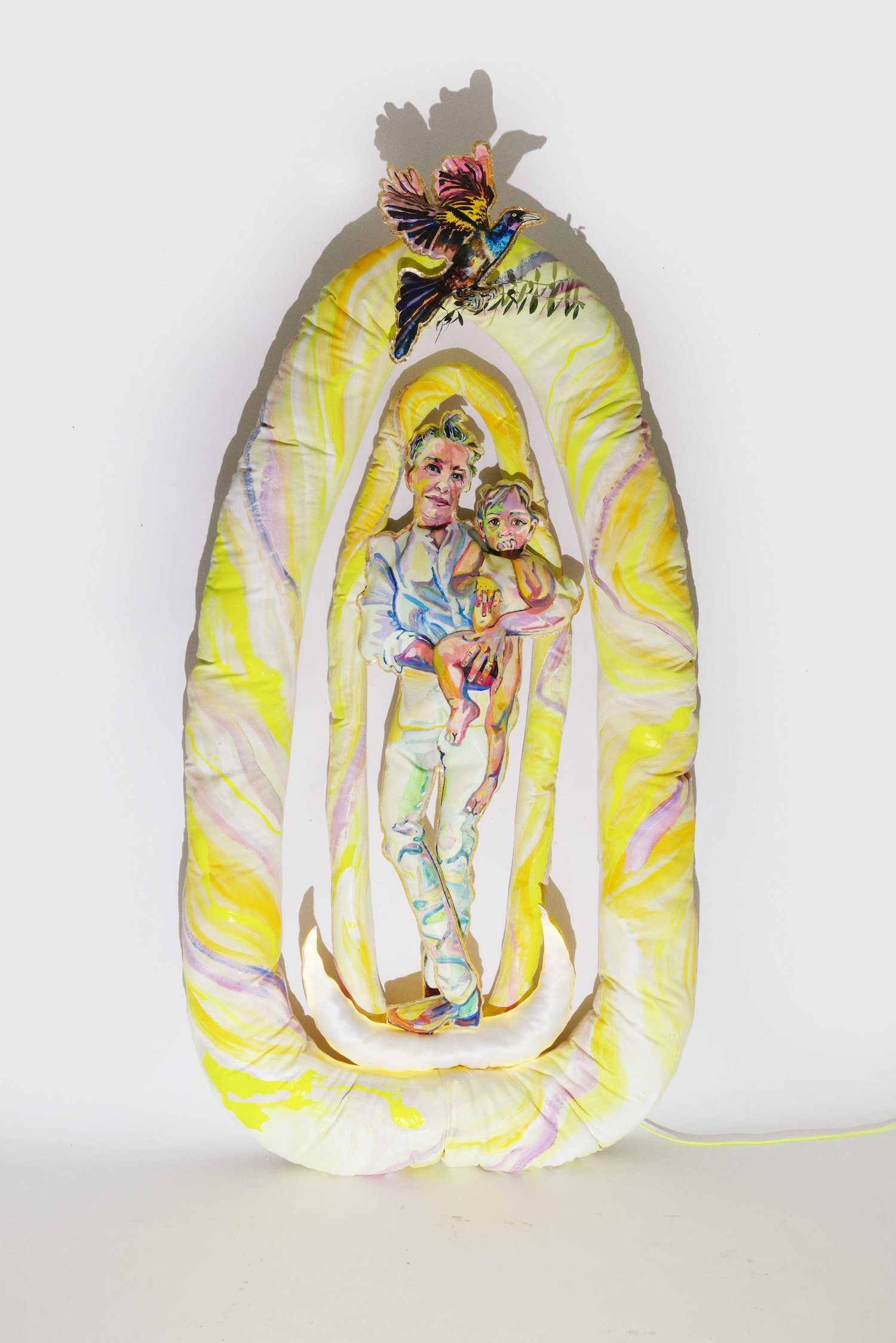Elizabeth Chapin
Nicolás Dumit Estévez Raful Espejo Ovalles Morel: I came across your exhibition Treespell at Women & Their Work, and while walking in Austin, Texas, with Lauz Bechelli. When I stepped into the gallery, I was immediately drawn to the materials and the images in your work. Can you tell me about the beings who inhabit your installation(s)?
Elizabeth Chapin: There are 8 tree beings that make up the forest, growing portraits of beloved trees. There is a growing/birthing figure of Artemis, god of wildness and birth. The forest is guarded/not guarded by 2 nymphs emerging from the pond. And there is the stag.
For every tree, while I painted, I took photos of my progress and then animated that process. The physical paintings were removed from the room and in their place, I created ghost replicas, like blank unruly screens or lumpy bodies, where the animations land, growing and ungrowing.
Artemis is modeled on a friend of my daughter who I have known since she was 6. So, like the trees, I photographed my progress of painting her as she is today, then I obliterated that painting and repainted her as her 6 year old self, while keeping the same silhouette of her 24 year old self. Then I obliterated that, over and over, creating shapes of her at every age and also documenting the awkward, unresolved in between paintings. Again, the physical painting was cast aside, and a ghost silhouette made on which the animation is projected. Girls and paintings growing and ungrowing.
The nymphs are myself and my daughter. I painted zippered theatrical gauze skinsuits, like selkie skins. The eyes are, like the Artemis idea, painted from my newborn photos all the way up to now. And my daughter’s eyes are forming and blinking. The eyes are somewhat obscured behind green blown glass, which is how I visualized them in a dream, but also refers to their transformation, or the fact that they are still inhabiting a different world.
Their fish “bonnets” are from an old halloween costume pattern I used for my children, and I added invisible zippered pockets for the eye video screens to slip into. These bonnets, covered in scales, coral, and barnacles, are like egg shell tops, the cracked remains of the tails from which the nymphs emerge. The tails are covered in 1000 paintings of frog habitats. Each painting is sewn onto a wired and zippered canvas tail, lined with deep red mohair, which reads as meat or guts.
The stag is a large canvas stuffed sculpture, bouncing on a steel twirly stand. On his blank canvas body, I projected videos of my dogs’ fur as they breathe and delight in the sun. His body is covered in coral velvet wound pockets from whence emerge whittled, gilt and feathered arrows, courtesy of our resident god. His glowing testicles are made from an old paint rag, wire brushed so that we can see the glow. The tail and ears are made from stitching hundreds of different kinds of yarn and thread together. The antlers are cedar branches. And his eyes mutate on screens tucked into hidden zippered pockets.
NDEREOM: I am wondering about the role of dreams and the unconscious in your creative praxis I am asking because of the layers that you generate while combining the physicality of fabric with the ethereality of video projections and screens. There is something in the installation that calls to be experienced from different states of awareness.
EC: The entire forest is meant to represent our collective unconscious shadow, as forests do. The nymphs, referential of fairy tale “prickly fish,” are slightly “devilish, unapproachable, slippery” creatures of the unconscious realm. (Marie-Louise Von Franz). Some interpreters insist that the stag is always representative of Artemis’s consciousness. I like this merging of hunter and hunted. But I also like the stag as the merging of our humanity’s consciousness, particularly male consciousness. He becomes a Saint. Sebastian in that way or even a Christ or Antichrist. Also, the entire idea emerged from 2 dreams. One where a beloved pond in Vermont (model for puddle tables) became a giant, dreaming green eye, content to stay put. And her staying put-ness was inviting me to listen more deeply. The other was a dream of a woman emerging from a zippered fish tail.
NDEREOM: I come from a Lebanese family in the Caribbean and I grew up surrounded by fabrics. Many of my relative had textile stores where I could get lost, daydream and enter a sculptural space within the day-to-day. What would you say has informed your installations?
EC: I love this response. I, too, grew up surrounded by fabric and obsessed with fabric stores. If my mom took me to a fashion store, I would sit on a bench by the door, refusing to go further, claiming I was short of breath. But in a fabric store, the bolts, upright like trees, were the raw materials of dreams. You could be anyone, you could become anyone. I learned to sew so that I could start in on this, making my own dance dresses, and later curtains and a wedding dress. I used to make soft fabric hand grenades, velvet shotgun shells, hybrid rat/dolls and food sculptures for my children. I sewed magnetized sardines leaping off of portraits and magnetized portraits of the dead on top of portraits of the living. So, I guess it was sneaking up on me. And then one day it just decided to take over.
NDEREOM: I am not particularly attracted to most art objects. I tend to gravitate toward mundane things and stuff that gets shaped out of an urgent need to give voice to something that has to be born. While looking at your work, I sensed an unavoidable call for a narrative to emerge. Would you be willing to talk about this?
EC: It did feel unavoidable. I drew this ghost forest and this girl presiding over it (probably me) and the narrative kept expanding. And I think that is how it works for me, why I am drawn to myths and Bible stories and fairy tales. They are these ancient archetypes that get to be rewritten over and over and over, with room in them, like in poems, to interpret or dissolve so you can find yourself there and you can find the world there, but you cannot find the answer. Because there isn't one. I started seeing the myth of Artemis as a fable of humanity, our long history of approaching the divine, approaching the wilds, and mistaking them for tools of empowerment, and I would like to turn that into a prayer. Something like “god of these wilds and god of my wild self, how do I remember that I do not approach you, because I am already within you.” And this started being a medicinal approach for my process as well. How can both the process and the result be sanctuary? How can I be in the tree while I paint her and how can the viewer also feel themselves inside of this energy?
NDEREOM: Where do the elements of your installations live when not in a gallery and what is your relationship to them beyond the exhibition space?
EC: They live all over our house. The playful aspect of paintings as environments is that the pieces can separate and come back together in all kinds of ways. Like paintings as modular couches. Or paintings that can literally hold hands with each other and with you. So, one of my creatures (who is one of the 3 graces in a “shower selfie”) is now living in one of the bathtubs in my house. The plants from a previous Eden are on mantels, an electrified iris is a night light in the bathroom, cowboys languishing in larkspur spill into the room, a birch adds a layer to a wall mural of trees, curtains from a moon temple divide rooms, and Eve wakes me up in the morning with the sun hitting her gilded edges. They surround me and each other.
NDEREOM: Have you thought about the possibility of your pieces finding home in an unexpected pace like a church, a temple, a hospital…? What would happen, in your opinion, if some of your pieces were to enter a realm other than art, like ritual, for example?
EC: A lot. I feel like they are altars, in a way, and I would love to see them in apses, arranged throughout a church like stations of prayer. I had not thought of hospitals until you mentioned it, but that idea is beautiful. Treespell could be a beautiful sanctuary for the sick and dying. It could bring the wilds of the world to someone who doesn’t have the strength to go out to it.
NDEREOM: Tell me about the mermaids. I have a fascination with these creatures. It is a long story, but I did a performance based on my encounter with a mermaid-like creature. Beings living below rivers are part of my spiritual upbringing.
EC: They are mermaid/nymph/selkie/prickly fish/sirens. They are hybrid creatures, partly in the world of water or the unconscious and partly in the forest and the dirt. They are me and my daughter separate but entwined. I have been thinking a lot about the idea of microchimerism, the fact that not only do my and my mother’s cells become a part of her, but her cells also become a part of me. And I have also been thinking about monsters or beasts. How beasts live on the edges of maps and worlds. Lauren Elkin says “we can understand a culture by what it calls monstrous; the monster stands for everything a society attempts to cast out. Monsters dwell at borders; you might even say the border creates the monster.” So, the nymphs and the stag are my border dwellers, as I try to blur the idea of borders.
NDEREOM: There is a lineage of artists who have worked with dolls: Elia Alba, Linda Mary Montano, and Louise Bourgeois. I am particularly into dolls and find them fascinating. What has been your experience with this?
EC: I played with dolls as a child and, for me, they are a portal – a way to build worlds. And sometimes children building worlds can be life-saving (Pan’s Labyrinth). As Carrie Mae Weems says, In seriousness there is little room for play but in play there is tremendous room for seriousness. Dolls can be friends, mirroring what you need, they can conjure spells or absorb evils. My large stuffed figures are very doll-like. I intentionally made the stag's legs fasten like a rag doll with giant horn buttons. It occurred to me recently that I was an indoor child and dolls were my medicine. And as an adult, living in the middle of the woods in Vermont in the summers (thanks to my father-in-law) the forest is my medicine. Treespell are these two worlds merging, and I think the videos, which are collapsing time, boundaries, and age, suggest this.
NDEREOM: The book of eyes in your show! The collection of eyes that are used in some of your fabric sculptures. I am being cryptic. I am not even articulating a question. Can you talk about this? The eyes of Jesus, those of DT (not to mention his name), and images of the eyes of many others move seamlessly–one into the other– in your videos and as one flips the pages of your book. I will let you describe this in detail.
EC: The Stag has over 400 frames of men’s eyes. I made a list of famous men beloved and reviled, and men I know intimately. I started with DT and then painted Putin on top of him and Rilke on top of him, Whitman, Gandhi, my son, etc, etc. I became fascinated with the spaces where the painting was both Putin and Rilke, the moment where it was more Rilke and then fully Rilke. It felt mystically like it was aligning with my desire to create this interconnected mycelial forest, the painting process echoing nonduality.
NDEREOM: What is your connection to Women & Their Work and how would you say your current installation there speaks with the histories of the space.
EC: I moved to Austin from NYC in 1999 and was on WTW’s board for a while. I have been a supporter and fan ever since. Their championing of women artists and the support they provide is crucial and rare. When I was thanking them in my speech at the opening, I likened what they do to being angel killers, in the Woolfian sense. Virginia Woolf said that in order to be an artist, a woman has to kill “the angel in the house.” And that angel is the voice inside your head that encourages modesty, helpfulness and charm, while questioning confidence, commitment to career, forthrightness, and the support of other women. WTW are professional angel killers.
NDEREOM: I thank you for this opportunity to hear from you and I hope to visit your exhibition at least once more.
EC: These are the best questions. Thank you for really being with the work.
All images and animations courtesy of Elizabeth Chapin
Elizabeth Chapins links: Website / Instagram / Women and Their Work
Elizabeth Chapin is a contemporary artist whose paintings explore the intimacy of bodies (human, arboreal and vegetal) – bodies as expansive environments – intra-connected, both containing and leaking within each other. This intimacy dissolves the illusion of gaze– of artist/subject and subject/viewer. Chapin sees archetype and myth as a way of holding our seemingly distinct experiences and bodies in the thicker flow of everything. Social media, the religion of identity, a modern mythology, perpetuates and broadcasts “self”, offering playful creativity, but also exile, distorting what it means to be connected, while maintaining systems of separateness. Chapin responds to these ideas with restless paintings that become bodies, tumble off the wall, fold into themselves, into you and into each other, paintings co-becoming.
Born in Mississippi, Chapin received her BFA at the University of Virginia and also studied at The Parson School of Design in Paris. Her work has been exhibited across the United States including New York City; Houston, TX; Austin, TX; New Orleans, LA; Nashville, TN; and Jackson, MS, among others. In 2020, she was awarded a residency in Florence, Italy, through Feminist Art Collective Toronto. In 2022, she was offered a 3 year mentorship under the acclaimed artists Shahzia Sikander and Holly Hughes. In 2023, Chapin was invited to participate in the biennial Sculpture Month Houston. Her solo exhibition Treespell opens January 27, 2024 at Women and Their Work in Austin, TX, where she lives and works.
Women & Their Work is a nonprofit visual and performing arts organization located in Central Austin that serves as a catalyst for new ideas in contemporary art created by women living and working in Texas and beyond. For over 46 years, Women & Their Work has brought groundbreaking art to Austin, with exhibitions, performances, and educational workshops. Women & Their Work seeks to ensure that our community is equitably and inclusively represented in art; that we foster the artistic growth of women by nurturing their development within the context of their communities and with work that responds to the moment; and share the art of our time with our audience. https://womenandtheirwork.org


